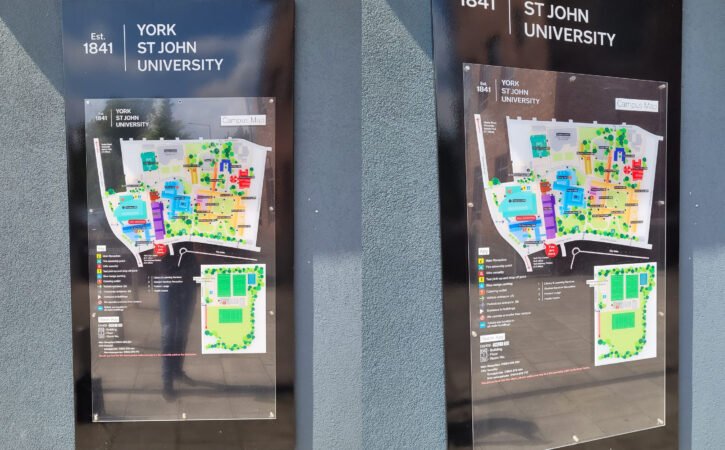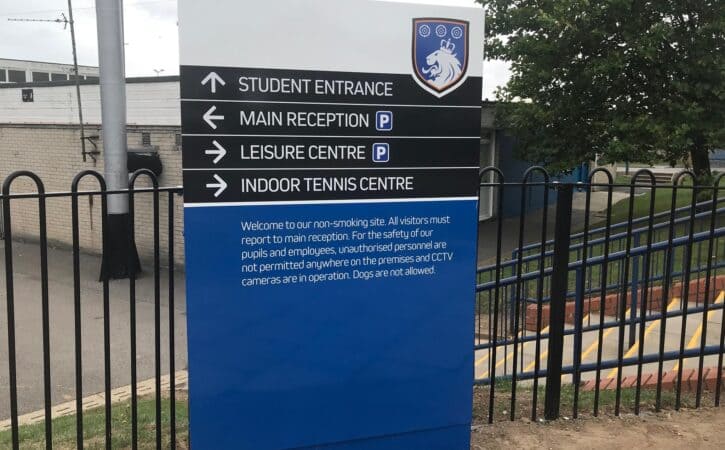Creating an environment where students feel informed, safe, and inspired is crucial for any educational institution. One of the key elements in achieving this is effective educational signage. From guiding students to their classrooms to promoting upcoming events, well-designed signage plays an integral role in the daily operations of a school. This article explores the various types of educational signage that every campus needs, and how they can support the school’s mission and enhance the student experience.
Custom Signs Every Campus Needs
Custom signs tailored to the unique needs of each campus can significantly improve communication and navigation. Here are the essential types of signage every school should consider.
Informational Signage
Informational signage is the first step in creating a positive first impression. High-quality, attention-grabbing signs can convey important information and ensure smooth daily operations. You can use traditional fixed signage on walls and above hallways or opt for LED screens that display rotating current information.
- Campus Maps: These help new students and visitors orient themselves and find their way around the campus with ease. Strategically placed maps are invaluable for large campuses.
- Visitor Information: Clearly visible signs that provide information for visitors, including check-in procedures and directions to key locations, enhance the visitor experience.
- Enrollment Dates: Highlighting important enrollment dates helps ensure that students and parents are aware of deadlines and procedures.
- Departments and Clubs: Signs indicating the location and information about various departments and clubs foster student involvement and engagement.
- Upcoming Events: Promotional signage for upcoming athletic events, performances, and other activities boosts attendance and school spirit.
- Future Testing Dates: Clearly displayed testing dates help students prepare and plan their schedules.
- Security Information: Providing important security information and emergency procedures ensures the safety of everyone on campus.
Wayfinding Signs
Wayfinding signs are essential for helping students, staff, and visitors navigate the campus efficiently. These signs should be strategically placed and designed for maximum visibility.
- Office and Building Directories: Clear directories at entrances help people find specific offices or departments.
- Hallway Signs: Signs indicating specific grades or departments reduce confusion and streamline movement.
- Room Numbers: Clearly marked room numbers ensure students and staff can easily locate classrooms.
- Restroom Signs: Visible and accessible restroom signs meet the needs of everyone on campus.
- Stairway or Elevator Access: Signs indicating the location of stairs and elevators for easier access.
- Parking Access: Clear signage for parking areas helps visitors and staff find appropriate parking spots.
- Food Station Signage: Signs indicating the location of food stations or cafeterias guide students during meal times.
- Library Signs: Signage for libraries indicating hours of operation and available resources enhances access to learning materials.
Promotional Signage
Promotional signage is used to inform and engage students about upcoming events, programs, and opportunities. Effective promotional signage can significantly boost participation and school spirit.
- Event Banners: Large banners promoting school events such as sports games, theatre productions, and guest lectures generate excitement and increase attendance.
- Digital Displays: Digital signage to promote daily announcements, event schedules, and important updates. These displays are versatile and can be updated easily to keep content fresh and relevant.
- Student Achievements: Highlighting student achievements with signage around the campus boosts morale and creates a sense of pride. Displaying photos and descriptions of accomplishments can inspire other students to strive for excellence.
Support Your School Through Effective Educational Signage
Effective educational signage supports the school’s mission by enhancing communication, fostering a positive environment, and promoting safety.
Enhancing Communication
Effective signage ensures that everyone on campus is informed and aware of important information.
- Consistent Messaging: Consistent messaging across all signs helps reinforce school values and policies. This consistency creates a cohesive environment where everyone understands and adheres to the same standards.
- Language Inclusivity: In multilingual campuses, providing signage in multiple languages ensures that non-native speakers can understand and follow directions. This inclusivity fosters a welcoming environment for all students.
- Regular Updates: Regularly updating signage to reflect current events, schedules, and changes ensures that the information remains relevant. Outdated signs can cause confusion and reduce their effectiveness.
Fostering a Positive Environment
Signage can contribute to a positive and inspiring school environment.
- Inspirational Quotes: Posting inspirational quotes around the campus can motivate students and create a positive atmosphere. These quotes can be related to perseverance, learning, and personal growth.
- Welcoming Messages: Signs that welcome new students and visitors create a friendly and inclusive atmosphere. First impressions matter, and welcoming signage can set a positive tone from the start.
- Cultural Celebrations: Highlighting cultural events and holidays through signage shows respect for diversity and encourages cultural awareness. This practice promotes inclusivity and understanding among students.
Promoting Safety
Safety is a top priority in any educational setting, and effective signage is a critical component of a comprehensive safety strategy.
- Emergency Procedures: Clearly displayed emergency procedures ensure that students and staff know what to do in case of fire, lockdown, or other emergencies. These signs should be prominently placed and easy to understand.
- Safety Reminders: Regular reminders about safety practices, such as wearing masks during a pandemic or not running in the hallways, help reinforce safe behavior. Visual reminders are particularly effective for younger students.
- Restricted Areas: Signage indicating restricted or staff-only areas helps prevent unauthorized access and ensures that students remain in safe, supervised areas.
The Benefits of Digital Signage in Schools
Digital signage offers numerous advantages over traditional static signs, providing a dynamic and interactive way to communicate.
Real-Time Updates
One of the most significant benefits of digital signage is the ability to provide real-time updates.
- Immediate Information: Administrators can instantly update digital signs with important announcements, changes to the schedule, or emergency alerts. This immediacy is crucial for maintaining effective communication.
- Automated Scheduling: Content can be scheduled to change automatically, ensuring that the right information is displayed at the right time. For example, morning announcements, lunchtime reminders, and end-of-day messages can be pre-scheduled.
- Event Countdown: Digital signs can display countdowns to important events, keeping students informed and excited about upcoming activities.
Interactive Features
Digital signage can include interactive elements that engage students and provide additional functionality.
- Touchscreen Maps: Interactive campus maps allow users to search for specific locations and get detailed directions. This feature is particularly useful for new students and visitors.
- Feedback Systems: Digital kiosks can be used to collect feedback from students about various aspects of school life. This feedback can be invaluable for making improvements and addressing concerns.
- Educational Content: Interactive displays can feature educational content, such as quizzes, puzzles, and learning modules. These elements can provide an engaging break from traditional classroom activities.
Energy Efficiency
Digital signage can be more energy-efficient than traditional signs, especially when using LED technology.
- Lower Power Consumption: LED displays consume less power than traditional lighting, reducing energy costs and environmental impact.
- Automatic Dimming: Digital signs can adjust their brightness based on ambient light levels, further conserving energy and ensuring optimal visibility.
- Sustainable Practices: Schools can demonstrate their commitment to sustainability by using energy-efficient digital signage and promoting eco-friendly messages.
Integrating Signage into the Campus Culture
To maximize the impact of educational signage, it should be seamlessly integrated into the campus culture.
Involving Students in Design
Engaging students in the design process can create a sense of ownership and pride in the signage.
- Student Art Projects: Incorporating student artwork into the design of signs can personalize the campus and showcase student talent. Art projects can be integrated into art classes or extracurricular activities.
- Design Contests: Holding design contests for new signs encourages creativity and participation. Winning designs can be displayed prominently, giving students a sense of accomplishment.
- Feedback Sessions: Regularly gathering student feedback on existing signage can help identify areas for improvement and ensure that signs meet the needs of the student body.
Consistent Branding
Consistent branding across all signage reinforces the school’s identity and creates a cohesive look.
- School Colors and Mascot: Incorporating school colors and the mascot into signage design fosters school spirit and unity. This consistent branding can be extended to all promotional materials and merchandise.
- Professional Design: Working with professional designers ensures that signage is visually appealing and effectively communicates the intended message. High-quality design reflects well on the school’s image.
- Uniform Fonts and Icons: Using uniform fonts and icons across all signs enhances readability and creates a polished, professional appearance.
Regular Maintenance and Updates
Keeping signage up-to-date and well-maintained is essential for long-term effectiveness.
- Routine Inspections: Regularly inspecting signs for damage, wear, and outdated information ensures they remain effective. This practice helps maintain a positive image and prevents confusion.
- Scheduled Updates: Planning regular updates to signage content keeps information relevant and engaging. Scheduled updates can include changes to maps, event promotions, and safety information.
- Cleaning and Repairs: Ensuring that signs are clean and in good repair prevents them from becoming eyesores and maintains their effectiveness. Regular cleaning and prompt repairs contribute to a positive campus environment.
Konklusion
Educational signage is an essential tool for enhancing communication, promoting safety, and creating a positive learning environment. By investing in custom signage solutions tailored to the unique needs of your campus, you can ensure that students, staff, and visitors have access to the information they need. From informational and wayfinding signs to promotional and digital displays, the right signage can make a significant difference in the overall functionality and atmosphere of your school. Partnering with a trusted provider like Signs&Logo ensures that your signage is of the highest quality and effectiveness, helping your school achieve its communication goals and support its educational mission.







Efterlad en kommentar